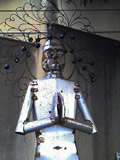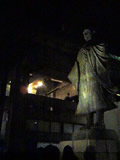

 |

|
Morioka's personal diary
If you have any comments please use our feedback form.
Please visit our blog. |
 |
For these couple of years I have sometimes been asked by email when the translation of Painless Civilization and/or The Insensitive Man is completed. Every time I am asked that question I reply that it would take a lot of time to translate these books. Actually, I have got a lot of things to do besides translating, and in addition, currently we do not have enough human resources for translation for some reasons.
Those who send me email usually says that the above books are worth publishing as a book in English. I think so too. However, I don't have enough time to translate them myself. Believe it or not, it takes more than a couple of hours for me to write each blog post, and another hours to examine the grammar. Still, I am afraid you may find some strange expressions in each blog post. Now, imagine how many hours are needed to translate a whole book!
In each translation, first an English native volunteer translator translates some paragraphs into English, and then I read it and see whether there are misunderstandings about the interpretation of the Japanese text, and I request some corrections, and after that I receive the final version. This is painstaking work, but at the same time, it's fun to collaborate to make good translation. Of course it is possible, if I had abundant research funding, to ask a professional translator to translate the whole book, but I believe this is not the best way because I am not sure if the translator "loves" the work he/she is to translate. Instead, in the case of volunteers, they have chosen to translate a particular paper or book themselves. In this sense, they have a wish to translate the particular work, and I believe this is the most important factor for good translation.
And I am still wondering what is the best way to publish the translated text. Most convenient way is to upload to our website in the HTML or PDF format. However, I also wish to publish as a book from a publisher, and in this case it would be a good idea not to upload to the website. I have published books from Japanese publishers, but I have never published from a foreign publisher, therefore I do not know how to approach them at all. Which publishers do you recommend me to approach?
Anyway, we are continuing to invite volunteers to translate my Japanese papers or books into English or other languages (for more information please see our Japanese website), or to edit the translated English texts.
Photo: Kyoto Seika University, Kyoto
What's New: .
Post a comment / See comments (Blog) |
 |
I have read an interesting article in The Washinton Post. It's William Saletan's "Shooting Pain," The Washinton Post, Sunday, February 18, 2007; page b02. Acording to Saletan, the US military has invented a new beam gun, which can cause unendurable pain without actually harming the body of a target person. A volunteer reporter said he felt as if he had been surrounded by fire when he experienced the power of the beam gun.
He says it felt like heat all over his body, as though his jacket were on fire. The feeling is an illusion. No one is harmed. The beam's energy waves penetrate just 1/64 of an inch into your body, heating your skin like microwaves. They inflame your nerve endings without burning you. This could be the future of warfare: less bloodshed, more pain. (web)
Imagine a battle field where US troops equipped with the beam guns shoot the enemies, or the terrorists, who do not have such weapons. What does it look like? Isn't it another form of "collective torture"? Actually, this technology can also be used as a useful tool for torture. Saletan, too, talks about the possibility of applying it to torture, and suggests that the use of this weapon on the street by the army won't be a crime under the current law.
People might think that causing unendurable pain in the battle field would be more humane than killing, but is this really true? In clinical settings, the patients who continuously experience unendurable pain sometimes would rather die than survive under such conditions. In the battle field, soldiers have to fight to the point that they cannot continue to fight, and this means that they continue to be exposed to unendurable pain caused by the enemy's beam weapons. Is it any different from a cancer patient suffering from severe pain on the bed?
Michel Foucault used the term "biopouvoir" or "biopower" to refer to the function of modern power in which people are forced to "live" rather than to be "killed." I believe what comes after the era of biopower will be the administration of "pleasure and pain" among ordinary people, and in the above case it appears as the controll of the pain of enemies in the battle field. This is one of the core messages of my book, Painless Civilization, published in 2003. It is a paradox that in the age of painless civilization the military seeks to invent painful weapons, and tries to spread across the world. I have to write a sequel to Painless Civlization in the near future.
Photo: A Buddhist temple, Osaka
What's New: .
Post a comment / See comments (Blog) |
 |
The paper, "Is it Morally Acceptable to Remove Organs from Brain-Dead Children?," Lancet Neurology, Vol.6, January, 2007, p.90, has been uploaded to our website. The idea that the brain dead children who have not declared their wish should have the right not to be exploited by the desire of adults is, I believe, a minority view not only in Japan but also in the world, but I don't think my argument is senseless or absurd. I would like to hear your comment about this topic. The Lancet is a super-famous medical journal, the impact factor of which is over 20.
By the way, I have just finished the paper, "What is Life Studies?," in Japanese. This paper will be published in the journal Gendai Bunmeigaku Kenkyu (Journal of Contemporary Civilization Studies) next month. I will try to summarize the core message of this paper in English, and rewrite "What is Life Studies" page as soon as possible.
The photo above was taken at Zushi Coast, Kanagawa Prefecture, last month. The wind was cold, and the waves were wild. I could see a number of seashells on the beach. The sea is the place where all life came out of, and where we return after we die and get cremated. The ocean is the matrix of life, and that is why we are attracted to the sea when we are tired and need some healing.
Photo: Zushi Coast, Kanagawa
What's New: Is it Morally Acceptable to Remove Organs from Brain-Dead Children?.
Post a comment / See comments (Blog) |
 |
I have read an interesting article entitled "Canadian seal hunters: We're not a "savage race"," written by David Ljunggren, Reuters, March 21st, 2007. According to the article, Canadian hunters kill small harp seals to get pelts and seal oil, by beating them with clubs. While protesters say "killing animals for their fur is barbaric," Canada's fisheries minister condemns their protest, saying that their efforts are futile. Ljunggren wrties as follows:
Critics say the fact that the bodies of seals jerk around after being clubbed shows the animals are suffering. Sealers describe the movements as muscle spasms and insist that a well-aimed blow with the blunt end of a hackapick club causes instantaneous death. (web)
And he cites the words of Raoul Jomphe, the director of a documentary film on this topic.
"There is a malaise in society. People have forgotten where food comes from," said Raoul Jomphe, the filmmaker. Why, the sealers wonder, do people not focus on what happens in commercial abattoirs? And what about the massive game hunts in Germany? (web)
I have discussed similar topics several times in this blog. The question I want to ask those activists is what they think about killing cows, pigs, and chicken for food. If they are all vegitarians and have struggled to abolish the whole meat industry, then I won't criticize them anymore. But if they insist that killing domesticated aminals should be accepted but killing wild animals are problematic, then I want to ask them the reason why they think so. If they say that certain wild animals are in danger of extinction, then the question arises what if hunting is managed in a sustainable way. If they say that killing wild animals is cruel, then the question arises what if the hunters kill them in the same way as in abattoirs. I once heard someone say that God gave us domesticated animals for food, hence it is ok to kill and eat them, but this sounds absurd to people who do not believe in Christianity (99% of the Japanese).
I have read another interesting article, "South Africa: Yengeni Slaughter Shows Deep Cultural Divisions" by Lance Greyling, Cape Argus, January 25th, 2007. This article discusses a similar subject, that is, the ritual sacrifice of a bull in South Africa. Greyling criticizes the idea that sacrificing a bull is a barabaric act. The following are from the article.
The often-used argument is that "our way of killing animals" is more humane than African sacrifice. I have visited many abattoirs and this argument does not hold water.
Killing is never humane. One particular image which sticks in my mind is that of a cow desperately trying to run up the steel walls of an abattoir production line in absolute fear of impending death. It nullifies anyone's argument that our so-called Western civilisation treats animals more humanely.
Modern society has simply found a way of mass slaughtering animals efficiently and removed the visual connection between the live animal and our neatly-packaged meat.
It is, therefore, enormously hypocritical for any meat-eater to condemn the African ritual killing of a bull. (web)
The last sentence is just what I want to say here. If we find something unpleasant about killing wild animals, what we should do first is to reconsider our way of eating which heavily depends on killing domesticated animals such as cows, pigs and chicken. The total number of killed seals or whales is astonishingly small compared with that of killed domesticated animals.
What do you think?
Photo: Zushi Coast, Kanagawa
What's New: .
Post a comment / See comments (Blog) |
|
